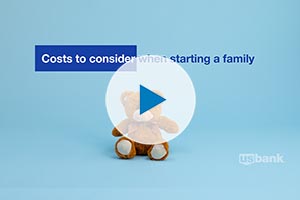
Webinar: Uncover the cost: Starting a family


FDIC-Insured - Backed by the full faith and credit of the U.S. Government
11 essential things to do before baby comes
A new, exciting chapter of life is upon you, expecting parents. Making financial and lifestyle arrangements now will minimize stress down the road – and allow you to spend more time doting on your newborn.
Excitement, joy, worry. When you’re anticipating a new baby, you may cycle through these emotions – the last one often tied to finances. How much will you need to adjust your budget now, and in the future, for the newest family member?
Set worries aside and start planning instead. Often, as with saving for college, starting small is better than not starting at all. Here’s a checklist of essential areas to address when prepping for baby. The efforts you make now will pay off in peace of mind for years to come.
Newborn home care and car basics
Your new bundle of joy will need a place to sleep and a car seat right away.
1. Buy an infant car seat: This is a must-have item, as you shouldn’t leave the hospital without it. Plus, most states have a law requiring that baby be in one. Keep in mind, you’ll likely need more than one car seat. Potentially, one that snaps in and out of a base during the infant stage; and one that converts as baby grows.
Note: major retailers often price match. If you have a specific brand and store in mind, compare prices online before purchasing. Some browser extensions even allow you to watch for price drops online. And, if you’ll need an extra base or two, consider borrowing from family or friends with the same model.
2. Figure out a safe crib or bassinet: Then expand toward ways to carry baby besides your arms, whether it’s a sling, baby backpack or stroller. Basically, list your needs first as you picture your child in your home space. Then list your wants – those things that can make life with less sleep easier on everyone.
3. Assess additional needs: Most other baby gear – and there are many, many items – is optional or can wait. For instance, you may want a changing table. But if money is tight, know many parents make do with a towel or changing pad on the floor. Think twice about diaper bags, too. Options abound, but a dedicated backpack that you already own could fulfill this function.
Keeping baby warm, dry and fed
Most hospitals provide a care kit with some essentials, such as a beanie, blanket and suction tube for cleaning out baby’s nose. And generous friends and family often gift clothes, blankets and one-time supplies at baby showers. But, you will need to budget for everyday basics: diapers, wipes, food, onesies, baby shampoo and nail clippers.
4. Make a plan for diapers: Did you know most babies go through eight to 10 diapers a day, at a cost of about 20 cents each? That can add up quickly, so compare cost-cutting options: cloth vs. disposable; diaper subscriptions; retail store promotions for bulk purchases.
5. Allot funds for feeding and clothes: Your little one will need to stay fed – possibly with bottles and formula, and eventually baby food. Making and freezing your own one-ingredient purées could help save money in the long run. Also take into account clothing (new and seasonal wear every three months) and cleanliness (wipes, toiletries, washcloths and towels).
Child care providers
With child care, you face a significant increase in your monthly expenditures. Costs vary by region, type of provider (in-home care, day care centers, nannies) and the amount of time in care. Always research your care provider thoroughly and seek references from people you trust.
6. Tour child care options early: Depending on the density of your area, child care options may fill up fast. It’s a good idea to visit and tour options, as there may be a waitlist – yes, a waitlist. If your family has two working parents, you’ll need to have a solid plan in place long before the baby arrives.
Childbirth costs and pre-tax benefits
Yes, birth is a miracle. But hospital stays and services also cost money. You can estimate how much in advance by speaking with your insurance company. And then begin to set aside money aimed at paying off that bill.
7. Research health savings plans: Consider taking advantage of Flexible Spending Accounts, also known as Flexible Spending Arrangements. Health FSA’s let you set aside up to $2,650 of pre-tax money to use for medical expenses. These can include things like co-pays, deductibles, some drugs and other medical costs. (The IRS has rules about what’s eligible.) Both you and your spouse can sign up for FSAs.
8. Another option to consider: a Health Spending Account (HSA). It’s another mechanism to have pre-tax money set aside for health expenses.
9. Sign up for a Dependent Care FSA: Similar to healthcare accounts, the IRS has a lengthy list of rules on eligibility. You’ll also want to familiarize yourself with what constitutes care and how spouses can both participate.
Add baby to your health insurance policy: Do this as soon after the birth as possible. Most policies allow a 30-day window, with some going up to 60 days. Don’t worry if you’ve already filled out your forms for the whole year. Private insurance and government programs allow a special enrollment period for major life events, such as a new child. If you’re insured through work, your human resources department can help with enrollment.
Life insurance for newborn
When you bring a little one home, you suddenly become aware of yourself as the protector. That means taking steps to ensure that should something happen to you, your dependents will be secure financially.
10. Consider increasing your coverage: You may already have life insurance as a work benefit, and you can increase your coverage amount. (Remember, the gist of life insurance is that you pay premiums over time, and should you die, your survivors receive a payout.)
If you do not have a policy through work, you can purchase one separately through a trustworthy company. A banker can help advise you on what to look for, and the government offers tips.
College savings plans
It’s not too early to think about saving for college, even when your child is an infant. Small but regular contributions to a designated account or investment fund can add up and compound over 18 or so years. That’s a big source of help when it’s time for your child to enroll.
11. Research a 529 plan: This college savings plan offers tax and financial aid benefits. It may also be used to save and invest for K-12 tuition. You can choose between a prepaid tuition plan and an education savings plan.
Sponsored by all 50 states and the District of Columbia, 529 prepaid plans are for a school in that state. Some states guarantee them and others don’t, and they can’t be used for room and board costs.
Education savings plans open an investment account for the beneficiary’s future school costs including room and board. It’s important to understand fees related to these plans, and also to understand their tax benefits.
Interested in starting a savings account for your current or future children? Explore options at U.S. Bank.
Related content

